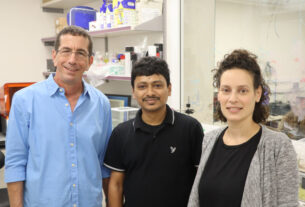A UK-based American pharmaceutical firm has had positive results so far in the late-stage trials for its treatment of Tay-Sachs disease, in what could be a major breakthrough for a condition disproportionately affecting Ashkenazi Jews.
Developed by IntraBio, the treatment, a drug dubbed IB1001, is being tested as a means of treating GM2 Gangliosidosis (Tay-Sachs and its variant, Sandhoff).
So far, the drug, which was taken orally dissolved in water, was tolerated by the child and adult patients, and no serious drug-related side effects were observed.
if(window.location.pathname.indexOf(“656089”) != -1){document.getElementsByClassName(“divConnatix”)[0].style.display =”none”;}else if(window.location.pathname.indexOf(“/israel-news/”) != -1){ document.getElementsByClassName(“divConnatix”)[0].style.display =”none”; var script = document.createElement(‘script’); script.src = ‘https://player.anyclip.com/anyclip-widget/lre-widget/prod/v1/src/lre.js’; script.setAttribute(‘pubname’,’jpostcom’); script.setAttribute(‘widgetname’,’0011r00001lcD1i_12258′); document.getElementsByClassName(‘divAnyClip’)[0].appendChild(script);}
Tay-Sachs is a rare inherited condition that impacts an estimated one out of every 200,000-320,000 live births. This is caused by the mutations in the HEXA gene that, ultimately, allows GM2 gangliosides to accumulate to the point of toxicity.
Those who suffer from the disease usually first show symptoms within six months after birth. This Infantile form usually results in reduced vision before progressing to seizures and gradual loss of mobility. Typically, the patient will die by the age of four or five. Other, rarer forms exist as well, with the juvenile form developing after the age of five and typically resulting in death around age 15.
Another, even rarer form is the late-onset adult form. Occurring later in life, the symptoms can theoretically manifest at any time. It progresses at a slower pace than the other forms, and is not usually fatal, though it will cause cognitive and physical deterioration.
The disease is rare, but is disproportionately more prevalent among Ashkenazi Jews. According to the National Organization for Rare Diseases (NORD), it is estimated that one in every 3,600 Ashkenazi live births is affected by Tay-Sachs. Both men and women are affected equally, and NORD estimates said that around one in 30 Ashkenazi Jews carries the Tay-Sachs gene.
Other demographics are affected by Tay-Sachs, too, such as among some French Canadians and Cajuns.
With the exception of the rare late-onset form, there is no real treatment for Tay-Sachs, and it always results in death.
 Orthodox Jews in New York (credit: REUTERS/CAITLIN OCHS)
Orthodox Jews in New York (credit: REUTERS/CAITLIN OCHS)The danger of Tay-Sachs is something that is well-known among Ashkenazi Jews, who have embraced genetic screening and testing since the 1970s. The disease’s reputation is so severe that there are even halachic opinions, such as from Rabbi Shlomo Auerbach and Rabbi Eliezer Waldenberg, that one may abort a fetus diagnosed with Tay-Sachs despite prevailing rabbinic Halacha usually opposing abortion in these circumstances.
Prevention methods do exist, however, with screening methods to ensure prospective parents are not both Tay-Sachs carriers. Such screening is free in Israel, the first country in the world to do so, as well as counseling. Due to this, the number of babies with Tay-Sachs born in Israel is actually very small, according to a 2013 statement to The Jerusalem Post from Jerusalem’s Shaare Zedek Medical Center.
Free screening is also available in the United Kingdom through the National Health Services (NHS).
But IntraBio’s trials could be a massive gamechanger for those carrying the Tay-Sachs gene or even suffering from the condition itself, as it is the first drug to show significant potential for application as a treatment.
“This is the first drug to offer hope to the patients and families affected by these devastating diseases,” Cure Tay-Sachs Foundation president Rick Karl and Cure Action CEO Dan Lewi said in a joint statement. “There is an urgent need for this effective treatment to be approved and made available for patients in our community before the window of therapeutic opportunity is lost.”
The company’s findings are set to be published in full next month in a peer-reviewed academic journal. In addition, further trials are also underway.




